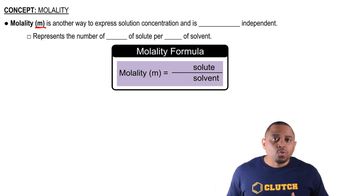Two beakers are placed in a sealed box at 25 °C. One beaker contains 30.0 mL of a 0.050 M aqueous solution of a nonvolatile nonelectrolyte. The other beaker contains 30.0 mL of a 0.035 M aqueous solution of NaCl. The water vapor from the two solutions reaches equilibrium. (b) What are the volumes in the two beakers when equilibrium is attained, assuming ideal behavior?
Ch.13 - Properties of Solutions
Chapter 13, Problem 104a
Carbon disulfide (CS2) boils at 46.30 °C and has a density of 1.261 g/mL. (a) When 0.250 mol of a nondissociating solute is dissolved in 400.0 mL of CS2, the solution boils at 47.46 °C. What is the molal boiling-point-elevation constant for CS2?
 Verified step by step guidance
Verified step by step guidance1
Identify the formula for boiling point elevation: \( \Delta T_b = i \cdot K_b \cdot m \), where \( \Delta T_b \) is the change in boiling point, \( i \) is the van't Hoff factor, \( K_b \) is the boiling-point-elevation constant, and \( m \) is the molality of the solution.
Calculate \( \Delta T_b \) by subtracting the boiling point of pure CS2 from the boiling point of the solution: \( \Delta T_b = 47.46 \text{ °C} - 46.30 \text{ °C} \).
Determine the molality \( m \) of the solution using the formula \( m = \frac{\text{moles of solute}}{\text{kilograms of solvent}} \). First, convert the volume of CS2 to mass using its density: \( \text{mass of CS2} = 400.0 \text{ mL} \times 1.261 \text{ g/mL} \). Then, convert this mass to kilograms.
Calculate the molality \( m \) by dividing the moles of solute (0.250 mol) by the mass of the solvent in kilograms.
Rearrange the boiling point elevation formula to solve for \( K_b \): \( K_b = \frac{\Delta T_b}{i \cdot m} \). Since the solute is nondissociating, \( i = 1 \). Substitute the values of \( \Delta T_b \) and \( m \) to find \( K_b \).

Verified video answer for a similar problem:
This video solution was recommended by our tutors as helpful for the problem above.
Video duration:
5mWas this helpful?
Key Concepts
Here are the essential concepts you must grasp in order to answer the question correctly.
Boiling Point Elevation
Boiling point elevation is a colligative property that describes how the boiling point of a solvent increases when a solute is dissolved in it. This phenomenon occurs because the presence of solute particles disrupts the solvent's ability to vaporize, requiring a higher temperature to reach the boiling point. The change in boiling point can be calculated using the formula ΔT_b = i * K_b * m, where ΔT_b is the boiling point elevation, K_b is the molal boiling-point-elevation constant, and m is the molality of the solution.
Recommended video:
Guided course

Boiling Point Elevation
Molality
Molality (m) is a measure of concentration defined as the number of moles of solute per kilogram of solvent. It is particularly useful in colligative property calculations because it directly relates to the number of solute particles in a given mass of solvent, independent of temperature and pressure. In the context of the question, the molality of the solution can be calculated by dividing the moles of solute by the mass of the solvent (in kg), which is essential for determining the boiling-point elevation.
Recommended video:
Guided course

Molality
Molal Boiling-Point-Elevation Constant (K_b)
The molal boiling-point-elevation constant (K_b) is a property specific to each solvent that quantifies how much the boiling point of the solvent increases per molal concentration of a non-volatile solute. It is determined experimentally and is crucial for calculating the boiling point elevation in solutions. In this problem, finding K_b involves rearranging the boiling point elevation formula to isolate K_b, allowing for the determination of this constant based on the observed boiling point change and the known molality of the solution.
Recommended video:
Guided course

Boiling Point Elevation
Related Practice
Textbook Question
Textbook Question
Carbon disulfide (CS2) boils at 46.30 °C and has a density of 1.261 g/mL. (b) When 5.39 g of a nondissociating unknown is dissolved in 50.0 mL of CS2, the solution boils at 47.08 °C. What is the molar mass of the unknown?
Textbook Question
Fluorocarbons (compounds that contain both carbon and fluorine) were, until recently, used as refrigerants. The compounds listed in the following table are all gases at 25 °C, and their solubilities in water at 25 °C and 1 atm fluorocarbon pressure are given as mass percentages. (a) For each fluorocarbon, calculate the molality of a saturated solution.
